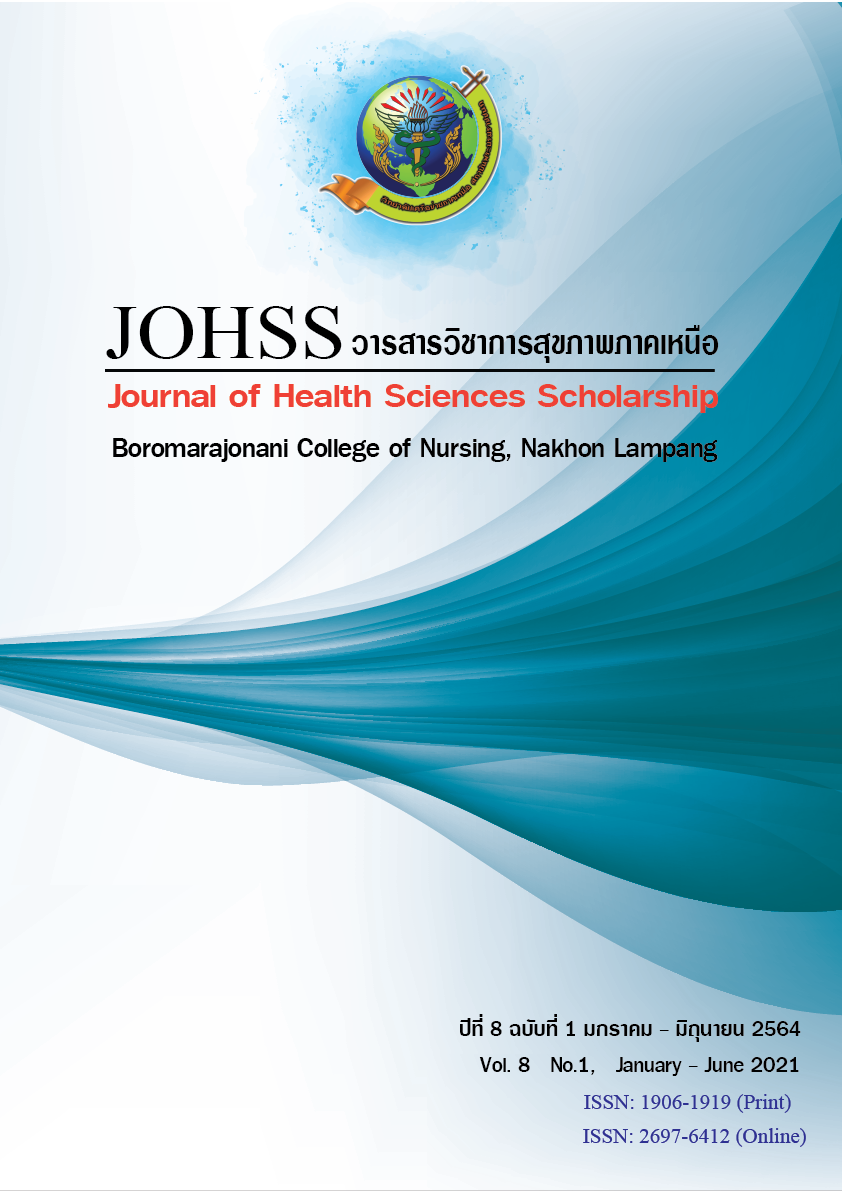ความสัมพันธ์ระหว่างความรอบรู้ด้านสุขภาพกับพฤติกรรมการบริโภคอาหารในผู้ป่วยโรคเบาหวานชนิดที่ 2 เขต รพ.สต. บ้านข่วง อำเภอห้างฉัตร จังหวัดลำปาง
คำสำคัญ:
ความรอบรู้ทางด้านสุขภาพ, พฤติกรรมการบริโภคอาหาร, ผู้ป่วยโรคเบาหวานชนิดที่ 2บทคัดย่อ
การวิจัยครั้งนี้เป็นการวิจัยเชิงพรรณนา มีวัตถุประสงค์เพื่อศึกษาความสัมพันธ์ระหว่างความรอบรู้ด้านสุขภาพกับพฤติกรรมการบริโภคอาหารของผู้ป่วยโรคเบาหวานชนิดที่ 2 ในเขต รพ.สต. บ้านข่วง กลุ่มตัวอย่าง มีจำนวนทั้งหมด 231 คน โดยการสุ่มอย่างง่าย ใช้แบบสอบถามแนวคิดความรอบรู้ทางด้านสุขภาพ มี 6 ด้าน ตามกรอบของ ดอน นัทบีม และกองสุขศึกษา กระทรวงสาธารณสุข แบบสอบถามพฤติกรรมการบริโภคอาหาร ที่ผู้วิจัยพัฒนาขึ้น ระยะเวลาในการศึกษาระหว่างเดือน พฤษภาคม – มิถุนายน 2563 โดยใช้แบบประเมิน และแบบประเมินพฤติกรรมการบริโภคอาหาร การวิเคราะห์ข้อมูลโดยสถิติพรรณนา ใช้สถิติวิเคราะห์สัมพันธ์ความรอบรู้ด้านสุขภาพกับพฤติกรรมการบริโภคอาหารของผู้ป่วยโรคเบาหวานโดยกำหนดระดับนัยสำคัญทางสถิติ ที่ระดับ 0.05 ใช้สถิติ Chi-square test
ผลการวิจัย พบว่า ผู้ป่วยโรคเบาหวานส่วนใหญ่มีระดับความรอบรู้ด้านสุขภาพอยู่ในระดับไม่ดี ร้อยละ 54.11 รองลงมาคือ ระดับระดับความรอบรู้ด้านสุขภาพพอใช้ ร้อยละ 22.94 เมื่อพิจารณาความรอบรู้ด้านสุขภาพจำแนกเป็นรายด้าน 6 ด้าน พบว่า ผู้ป่วยโรคเบาหวานมีความรอบรู้ด้านสุขภาพสูงที่สุดในเรื่องการเข้าถึงข้อมูลสุขภาพและบริการสุขภาพ ร้อยละ 79.12 รองลงมาคือทักษะความเข้าในด้านสุขภาพ ร้อยละ 68.89 ต่ำสุด คือ ทักษะการตัดสินใจร้อยละ 62.23 ระดับพฤติกรรมการบริโภคอาหารผู้ป่วยโรคเบาหวาน ส่วนใหญ่อยู่ในระดับไม่ดี ร้อยละ 57.58 รองลงมาคือระดับพอใช้ ร้อยละ 24.67 และความรอบรู้ด้านสุขภาพมีความสัมพันธ์กับพฤติกรรมการบริโภคของผู้ป่วยโรคเบาหวานชนิดที่ 2 อย่างมีนัยสำคัญทางสถิติที่ .01
ข้อเสนอแนะการสร้างเสริมความรอบรู้ด้านสุขภาพในผู้ป่วยเบาหวานควรมุ่งเน้นให้ผู้ป่วยมีความรอบรู้ด้านสุขภาพในระดับดีขึ้นไปในทั้ง 6 ด้าน จึงจะส่งผลดีต่อผลลัพธ์ต่อการควบคุมระดับน้ำตาลในเลือดได้
เอกสารอ้างอิง
Aekplakorn, W. (Ed.). (2014). The fifth national health examination survey 2014. Nonthaburi: health system
research institute. (in Thai).
American Diabetes Association. (2015).Standards of medical care in diabetes-2015 abridged for primary care
providers. Clin diabetes. 33(2), 97-111. doi:10.2337/diaclin.33.2.97.
American Diabetes Association. (2017). Standards of medical care in diabetes-2017.Diabetes care. 40 (suppl.1),
s1-s135.
DeWalt, D. A., Berkman, N. D., Sheridan, S., Lohr, K. N., & Pignone, M. P. (2004). Literacy
and health outcomes: A systematic review of the literature. Journal of general
internal medicine, 19(12), 1228–1239.
Gazmararian et al.(1999). Effects of health literacy on health status and health service utilization amongst the
elderly, Social science & medicine. 66(8), 1809-1816.
Gazmararian JA, Baker DW, Williams MV, Parker RM, Scott TL, Green DC, et al. (1999). Health literacy among
medicare enrollees in a managed care organization. JAMA. 281 (6): 545-51.
Ginggeaw, S. and Prasertsri, N. (2015). The relationship between health literacy and health behaviors of the
elderly with multiple chronic diseases. Nursing journal of the ministry of public health. 25(3):43-54. (in Thai)
HDC.(2020). Lampang HDC. (online), Available: https://lpg.hdc.moph.go.th/hdc/reports/report.
php?ource=pformated/format1. php&cat_id=b2b59e64c4e6c92d4b1ec16a599d882b&id
=137a726340e4dfde7bbbc5d8aeee3ac3.(2020, 9 February). (in Thai).
Kim, S. H., & Youn, C. H. (2015). Efficacy of chronic disease self-management program in older Korean adults with
low and high health literacy. Asian nursing research, 9(1), 42-46.
Krejcie, R. V. & Morgan, D. W. (1970). Determining sample size for research activities.
Educational and psychological measurement. 30(3), pp. 607-610.
National Health Security Office of Thailand. (2015). An assessment on quality of care among patients diagnosed
with type 2 diabetes and hypertension visiting hospitals of ministry of public health and Bangkok
metropolitan administration in Thailand.Retrieved from :
http://www.skto.moph.go.th/ssj/disease/tb/download/NCD%2059. (in Thai).
Norasing Montree ,Thanomphan Sutthiphan.(2019). Health literacy and health behavior in patients with
uncontrolled blood sugar level or blood pressure: a case study of Nakornping Hospital, Chiang Mai. Journal of
nakornping hospital 2019, 10 (1), 36-49. (in Thai)
Nutbeam D. (1986). Health promotion glossary. Health promot, 1(1),113-127.
Nutbeam D.(1999). Health promotion glossary. Health promotion international.13(4), 349-364.100.
Nutbeam D . (2008). Health literacy as a public health goal: a challenge for contemporary health education and
communication strategies into the 21st century. Health promotion international. 15(3), 259-267.
Ogurtsova et al. (2017). IDF diabetes atlas: global estimates for the prevalence of diabetes for 2015 and 2040.
Diabetes research and clinical practice, 128, 40-50
Schillinger et al. (2002). Association of health literacy with diabetes outcomes. Journal of the american medical
association, 288, 475-482.
Speros, C. I. (2009). More than words: promoting health literacy in older adults. OJIN: The online journal of issues
in nursing. 14(3).
Sriwong Nipaporn. (2019). Self-care behaviors of type II diabetes mellitus patients attending sub-district health
promoting hospital. Journal of health science 2019. 28(4): 620-27.(in Thai)
ดาวน์โหลด
เผยแพร่แล้ว
ฉบับ
ประเภทบทความ
สัญญาอนุญาต
ลิขสิทธิ์ (c) 2021 วารสารวิชาการสุขภาพภาคเหนือ

อนุญาตภายใต้เงื่อนไข Creative Commons Attribution-NonCommercial-NoDerivatives 4.0 International License.
บทความ ข้อมูล เนื้อหา รูปภาพ ฯลฯ ที่ได้รับการตีพิมพ์ในวารสารวารสารวิชาการสุขภาพภาคเหนือ ถือเป็นลิขสิทธิ์ของวารสารวารสารวิชาการสุขภาพภาคเหนือ หากบุคคลหรือหน่วยงานใดต้องการนำทั้งหมดหรือส่วนหนึ่งส่วนใดไปเผยแพร่ต่อหรือเพื่อกระทำการใดๆ จะต้องได้รับอนุญาตเป็นลายลักอักษรจากวารสารวารสารวิชาการสุขภาพภาคเหนือก่อนเท่านั้น
เนื้อหาและข้อมูลในบทความที่ลงตีพิมพ์ในวารสารวิชาการสุขภาพภาคเหนือถือเป็นข้อคิดเห็นและความรับผิดชอบของผู้เขียนบทความโดยตรงซึ่งกองบรรณาธิการวารสาร ไม่จำเป็นต้องเห็นด้วย หรือร่วมรับผิดชอบใดๆ
อนึ่ง ข้อความและข้อคิดเห็นต่างๆ เป็นของผู้เขียนบทความนั้นๆ ไม่ถือเป็นความเห็นของวารสารฯ และวารสารฯ ไม่จำเป็นต้องเห็นด้วยกับข้อความและข้อคิดเห็นใดๆ ของผู้เขียน วารสารฯ ขอสงวนสิทธิ์ในการพิจารณาตีพิมพ์ตามความเหมาะสม รวมทั้งการตรวจทานแก้ไขหรือขัดเกลาภาษาให้ถูกต้องตามเกณฑ์ที่กำหนด



